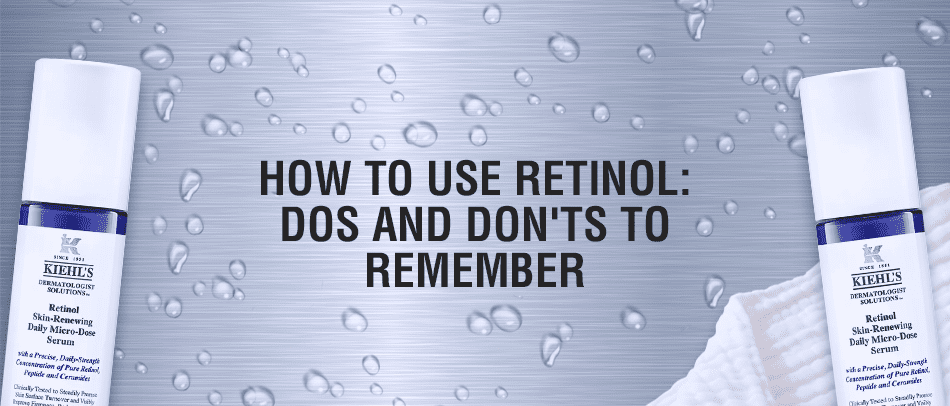If you’re a self-proclaimed skincare lover, you’ve probably heard of retinol and its wonders for your skin.
Retinol is said to reduce the appearance of fine lines and wrinkles by amping up your skin’s collagen production. It can also stimulate the production of new blood vessels that can improve your skin tone. Lastly, it’s a great ingredient that promotes cell turnover or the resurfacing of your skin’s younger cells, which can help prevent acne and scarring.
However, while a retinol serum has many benefits, it’s a tricky ingredient to use. If you’ve been using retinol for a while now but haven’t seen any results, don’t panic; it might just be because you’re not using it the right way.
Here, we’ve listed some dos and don’ts of using retinol so you can see its effects better.
Dos
- Do start slow
Retinol is a fairly potent ingredient. It can irritate your skin if used too often or if the formulation is too strong. Knowing how to use retinol serum safely and effectively is essential to seeing its results. Your skin needs to acclimate to new products and ingredients, so it’s best to start with small amounts twice a week if you’re new to retinol.
Kiehl’s Micro-Dose Retinol Serum is a great way to start your retinol journey. The micro-dose formula is gentler than other retinol products. It’s potent enough to visibly reduce wrinkles and even skin tone with minimal discomfort, making it the ideal product for those just starting to use retinol.
- Do moisturize generously
Understanding what retinol is means knowing what it does. As mentioned, retinol promotes cell turnover, but this, in turn, can cause dry and flaky skin. You need to keep your skin hydrated and plump to ensure that it does not get dried out or irritated.
If you have highly sensitive skin, you can try mixing your retinol serum with your moisturizer to make the product gentler. Our Microdose Retinol Serum has extra skin-loving ingredients that lock in moisture:
- Niacinamide – helps stimulate the production of ceramides and proteins that keep your skin firm and healthy
- Ceramides – are fats that make up 30 to 40% of your outer skin layer, so they’re responsible for maintaining your natural moisture barrier and protecting against external irritants
- Peptides – repairs damaged skin cells and stimulates the production of collagen, giving your skin a youthful glow
- Do use retinol only at night
Staying on the topic of highly sensitive skin, it would be best to use your retinol serum only at night to avoid photosensitivity. Retinol can make your skin more sensitive to UV rays, which can lead to sun damage and other issues like redness and irritation.
Cell turnover eliminates dull skin cells on the surface to make way for new ones by “pushing” the old ones out; however, the healthy skin cells can easily burn if left unprotected.
- Do use retinol regularly
As they say, consistency is key. Try using a retinol serum, like Kiehl’s Microdose Retinol Serum, which is specially formulated for daily use, to maximize the benefits of retinol without any side effects. Also, remember to be patient—retinol starts showing results around 12 weeks of usage.
Don’ts
- Don’t use retinol with other active ingredients
Retinol doesn’t mix well with certain ingredients. Like retinol, AHA and BHA are also exfoliating, so using these ingredients together can be very drying and cause further irritation to the skin. Benzoyl peroxide, meanwhile, cancels the effects of retinol. Lastly, vitamin C protects the skin from environmental aggressors but is better used separately from retinol than together.
Instead, pair retinol with ingredients that hydrate or help the skin retain moisture. Examples are hyaluronic acid and niacinamide.
- Don’t apply too much product
Applying too much retinol can cause your skin to react badly. Skin discoloration, swelling, or acne flare-ups are common side effects of prolonged, high-dosage retinol use. Using too often or a dosage too strong for your skin can cause peeling and excessive dryness, which can eventually lead to skin thinning. Learn how to use retinol for beginners to get just the right dosage for your skin.
- Don’t skip the sunscreen
As we’ve said, retinol is a photosensitive ingredient. Since retinol can make your skin more vulnerable to sun damage, your best bet is to use a sunscreen with a high SPF to protect against harmful UV rays.
- Don’t use it when pregnant
Topical and oral vitamin A products like retinol may interfere with the development of the fetus. Using retinol during pregnancy may result in fetal retinoid syndrome. This is a pattern of physical and mental congenital disabilities that directly relate to retinoids, so it’s best to avoid retinol if you’re pregnant.
Practice Caution for Best Results
Like other skincare products, retinol serums take some getting used to, and knowing how to use them correctly can significantly help their effectiveness. Your skin needs to get accustomed to the ingredient first before it can start absorbing the benefits.
Choose a retinol serum in the Philippines that’s gentle on the skin but highly effective. Kiehl’s offers an effective retinol serum for daily use, plus a wide range of skincare products that can help with your unique skin concerns. Shop the Kiehl’s Micro-Dose Retinol Serum today or message us on Facebook for a free skin consultation.

